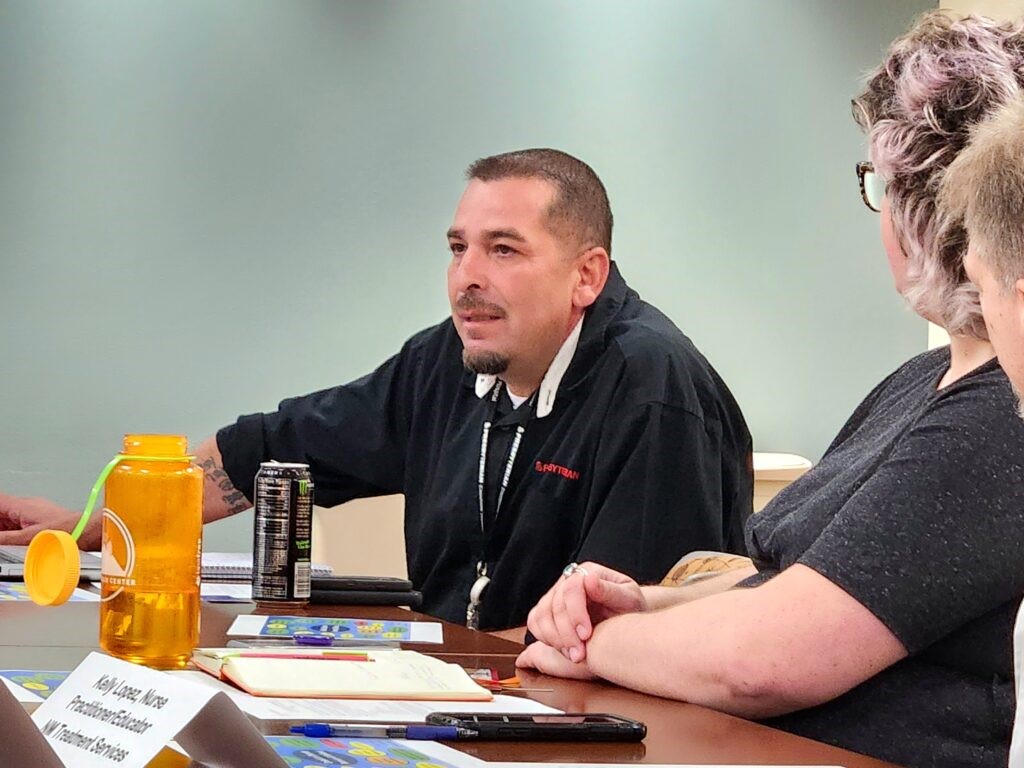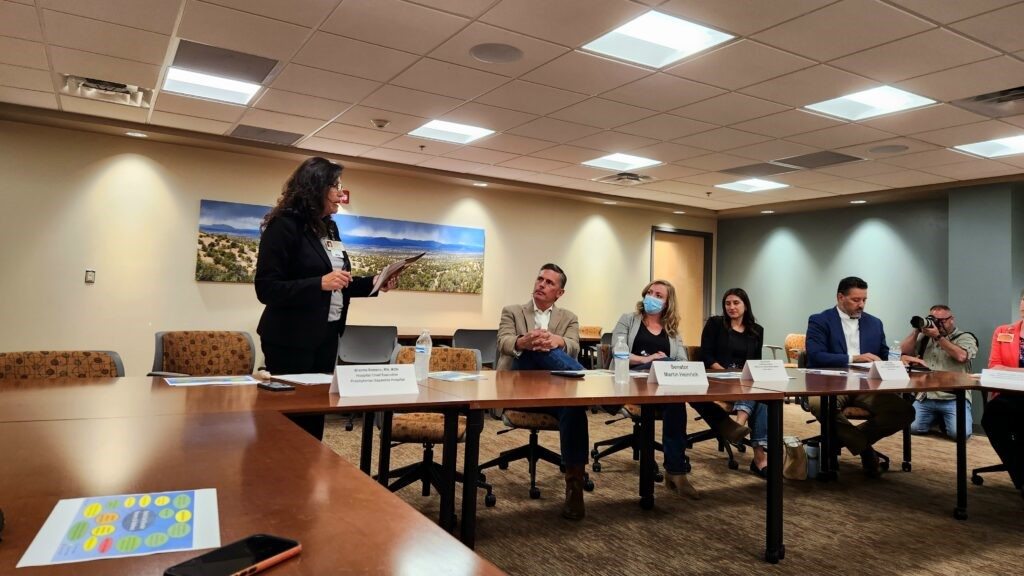Lifesaving treatment
Dear Friend,
The heartache of losing a loved one to the opioid epidemic is not new to New Mexico families. But the danger has grown with the magnitude and lethality of fentanyl making its way into our schools and communities.
Earlier this month, I talked with health care providers in the Española Valley about their work helping those recover from substance use disorder and the challenges caused by limited access to buprenorphine—a proven, lifesaving medication for opioid use disorder. I hope you can take a moment to read and share the story below from Source NM about our discussion.
This conversation built on a letter I led to the DEA earlier this year calling on them to increase access to prescriptions for buprenorphine. I recently included language tackling this issue in the Commerce, Justice, and Science funding bill that was voted out of the Appropriations Committee.
My language directs the DEA to remove barriers to access for opioid use disorder medications, including buprenorphine. This will help local medical and mental health providers, like the ones I met with in Española, as they help their patients access buprenorphine prescriptions.
I am also working to pass bipartisan legislation in Congress to cut off the illicit supply of fentanyl that is flooding into our communities from China and Mexico – legislation like the FEND Off Fentanyl Act. I helped to successfully include the FEND Off Fentanyl Act as part of the annual defense bill that the Senate expects to pass this week.
Earlier this month, I successfully passed language out of the Appropriations Committee to direct the DEA to develop a comprehensive fentanyl tracking system. This new comprehensive tracking system will be critical to better understanding the movement of illicit drugs into and within the United States and more effectively combatting the fentanyl drug epidemic.
We need to use every available tool to urgently take on this deadly epidemic and help our friends and family members access the treatment and support they need to heal their addiction.
Sincerely,
Addiction medication scripts going unfilled in northern New Mexico
Senator says federal law should ‘lean more on therapy and less on bureaucracy’
By Austin Fisher - July 6, 2023

Ronnie Flores, a peer support specialist at Presbyterian Española Hospital, speaks on Wednesday during a meeting with U.S. Sen. Martin Heinrich. (Photo by Austin Fisher / Source NM)
ESPAÑOLA—Ronnie Flores feels more comfortable on the streets talking to people who are using drugs than he does talking to the people in the hospital who are treating substance use disorder.
As a peer support specialist at Presbyterian Española Hospital, Flores helps people suffering from substance use disorders relating to opioids, stimulants and alcohol.
Flores, who was born in the Española area and is in recovery himself, helps patients get started on medication-assisted treatment, schedule their follow-up appointments and ensure they actually get to those appointments.
But Flores and other addiction treatment workers say even if someone can get a prescription for medication that will help them manage their conditions, actually getting it filled in northern New Mexico is often so difficult that people give up on treatment altogether.
“We don’t have pharmacies that have enough buprenorphine,” Flores told U.S. Sen. Martin Heinrich and his staff during a meeting at the hospital on Wednesday.
Buprenorphine is an FDA-approved medication for opioid use disorder that can be prescribed without the patient having to go into a clinic, and can be sold at retail pharmacies. Both buprenorphine and methadone have been shown to reduce overdoses and opioid-related deaths.
Researchers last year found restrictive federal regulations on how pharmacies can dispense the drug have led to delayed or suspended shipments. It’s also caused buprenorphine prescriptions getting declined and not filled to people in need.
Another study published in May found that only 57.9% of pharmacies in the United States reported having buprenorphine or naloxone in stock; only 42 pharmacies in all of New Mexico carry the drugs.
The unmet need was fresh in the mind of Leslie Hayes, a primary care physician at El Centro Family Health, which is associated with the hospital. On Monday, four different patients called in saying they couldn’t get their prescriptions for buprenorphine filled because the pharmacies didn’t have them, she said.
Two of those patients had to visit three different pharmacies before they could finally get the medication, Hayes said.
Kelly Mytinger, who manages the harm reduction program at the Santa Fe Mountain Center, said the nurse there spends easily two to three hours per day on the phone on hold with pharmacies trying to sort out people’s prescriptions.
“It ends up being really disruptive during her workday and for our patients,” Mytinger said.
When a patient new to recovery doesn’t get their prescription, they often experience shame and are left thinking they’ve done something wrong, Hayes said.
“Even from my long-term patients in recovery, they feel very ashamed about it, but for the new patients, it’s often enough of a barrier that they don’t come back,” she said.

Presbyterian Española Hospital Administrator Brenda Romero (left) speaks Wednesday, while U.S. Sen. Martin Heinrich listens. (Photo by Austin Fisher / Source NM)
Inconsistent DEA messaging
Vanessa Lucero, pharmacy director at the hospital, said prescription drug distributors are holding pharmacies to unforeseen, unwritten rules and regulations governing how to treat people with buprenorphine.
In December, when the hospital was nearing its limits for dispensing methadone, Lucero said she could only continue treatment by switching patients to tablets instead of liquid, and giving others more morphine.
In meetings with regulatory directors for two different prescription drug distributors, Lucero explained why she needed methadone and how she uses it with patients.
“My opinion about it is that they don’t want to be sued as well, so they’re limiting all of us what they can provide,” Lucero said.
Lucero asked the DEA to increase her maximum amount of methadone, but they never gave her an explicit limit.
After scores of pages of paperwork and a written interview with the agency, Lucero was only able to increase their stock by a single bottle, which she said is an insignificant amount for the number of patients at the hospital.
There is no uniform message from the U.S. Drug Enforcement Administration about limits on buprenorphine stocks at pharmacies, Hayes said.
“Our DEA officers have told us very specifically that there is no limit on the amount of buprenorphine the pharmacies can have,” Hayes said.
However, Hayes said addiction medicine physicians have told her that DEA officers said there are limits on how much pharmacies can carry.
Drug distributors and pharmacies do not have any clear directives, said Eric Ketcham, an emergency physician and addiction specialist at the hospital.
The problem stems from two issues, Ketcham said.
The first is with the Suspicious Order Reporting System, he said, which was created by a 2018 federal law that is up for renewal this summer.
The DEA mandates all prescription drug suppliers to track pharmacy orders of controlled substances through the centralized database, and suppliers must notify the DEA of pharmacy orders of opioids that are unusually large or considered suspicious.
The second underlying problem, Ketcham said, is that similar requirements were written into the federal opioid settlements.
“All they know is it’s gonna fall on them, or they’re gonna get in trouble with the DEA, so everybody’s being very conservative setting these limits, but it’s very nebulous,” he said.
After listening to the addiction workers speak, Heinrich said the problems they’re describing are unintended consequences from the change in the law, and a result of improper weighing of the risks versus the impact of people not getting treatment and returning to using fentanyl.
“We clearly don’t have that balance right, and we need to figure out how we lean more on therapy and less on bureaucracy,” Heinrich said.
